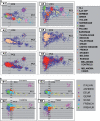Genome-wide association study identifies novel loci predisposing to cutaneous melanoma
- PMID: 21926416
- PMCID: PMC3298855
- DOI: 10.1093/hmg/ddr415
Genome-wide association study identifies novel loci predisposing to cutaneous melanoma
Abstract
We performed a multistage genome-wide association study of melanoma. In a discovery cohort of 1804 melanoma cases and 1026 controls, we identified loci at chromosomes 15q13.1 (HERC2/OCA2 region) and 16q24.3 (MC1R) regions that reached genome-wide significance within this study and also found strong evidence for genetic effects on susceptibility to melanoma from markers on chromosome 9p21.3 in the p16/ARF region and on chromosome 1q21.3 (ARNT/LASS2/ANXA9 region). The most significant single-nucleotide polymorphisms (SNPs) in the 15q13.1 locus (rs1129038 and rs12913832) lie within a genomic region that has profound effects on eye and skin color; notably, 50% of variability in eye color is associated with variation in the SNP rs12913832. Because eye and skin colors vary across European populations, we further evaluated the associations of the significant SNPs after carefully adjusting for European substructure. We also evaluated the top 10 most significant SNPs by using data from three other genome-wide scans. Additional in silico data provided replication of the findings from the most significant region on chromosome 1q21.3 rs7412746 (P = 6 × 10(-10)). Together, these data identified several candidate genes for additional studies to identify causal variants predisposing to increased risk for developing melanoma.
Figures







Similar articles
-
Genetic analysis of three important genes in pigmentation and melanoma susceptibility: CDKN2A, MC1R and HERC2/OCA2.Exp Dermatol. 2010 Sep;19(9):836-44. doi: 10.1111/j.1600-0625.2010.01115.x. Epub 2010 Jul 14. Exp Dermatol. 2010. PMID: 20629734
-
Genome-wide association study identifies a new melanoma susceptibility locus at 1q21.3.Nat Genet. 2011 Oct 9;43(11):1114-8. doi: 10.1038/ng.958. Nat Genet. 2011. PMID: 21983785 Free PMC article.
-
Genome-wide association meta-analyses combining multiple risk phenotypes provide insights into the genetic architecture of cutaneous melanoma susceptibility.Nat Genet. 2020 May;52(5):494-504. doi: 10.1038/s41588-020-0611-8. Epub 2020 Apr 27. Nat Genet. 2020. PMID: 32341527 Free PMC article.
-
Comprehensive field synopsis and systematic meta-analyses of genetic association studies in cutaneous melanoma.J Natl Cancer Inst. 2011 Aug 17;103(16):1227-35. doi: 10.1093/jnci/djr219. Epub 2011 Jun 21. J Natl Cancer Inst. 2011. PMID: 21693730 Free PMC article. Review.
-
Genome-wide association studies of pigmentation and skin cancer: a review and meta-analysis.Pigment Cell Melanoma Res. 2010 Oct;23(5):587-606. doi: 10.1111/j.1755-148X.2010.00730.x. Epub 2010 Jul 16. Pigment Cell Melanoma Res. 2010. PMID: 20546537 Free PMC article. Review.
Cited by
-
HERC Ubiquitin Ligases in Cancer.Cancers (Basel). 2020 Jun 22;12(6):1653. doi: 10.3390/cancers12061653. Cancers (Basel). 2020. PMID: 32580485 Free PMC article. Review.
-
Integrated pathway and epistasis analysis reveals interactive effect of genetic variants at TERF1 and AFAP1L2 loci on melanoma risk.Int J Cancer. 2015 Oct 15;137(8):1901-1909. doi: 10.1002/ijc.29570. Epub 2015 May 26. Int J Cancer. 2015. PMID: 25892537 Free PMC article.
-
Pan-cancer association of DNA repair deficiencies with whole-genome mutational patterns.Elife. 2023 Mar 8;12:e81224. doi: 10.7554/eLife.81224. Elife. 2023. PMID: 36883553 Free PMC article.
-
New susceptibility loci for cutaneous melanoma risk and progression revealed using a porcine model.Oncotarget. 2018 Jun 12;9(45):27682-27697. doi: 10.18632/oncotarget.25455. eCollection 2018 Jun 12. Oncotarget. 2018. PMID: 29963229 Free PMC article.
-
A Genome-Wide Association Study Identifies Two Novel Susceptible Regions for Squamous Cell Carcinoma of the Head and Neck.Cancer Res. 2020 Jun 15;80(12):2451-2460. doi: 10.1158/0008-5472.CAN-19-2360. Epub 2020 Apr 10. Cancer Res. 2020. PMID: 32276964 Free PMC article.
References
-
- Siegel R., Ward E., Brawley O., Jemal A. Cancer statistics, 2011: the impact of eliminating socioeconomic and racial disparities on premature cancer deaths. CA Cancer J. Clin. 2011;61:212–236. - PubMed
-
- Cust A.E., Schmid H., Maskiell J.A., Jetann J., Ferguson M., Holland E.A., Agha-Hamilton C., Jenkins M.A., Kelly J., Kefford R.F., et al. Population-based, case-control-family design to investigate genetic and environmental influences on melanoma risk: Australian Melanoma Family Study. Am. J. Epidemiol. 2009;170:1541–1554. - PMC - PubMed
-
- Meyle K.D., Guldberg P. Genetic risk factors for melanoma. Hum. Genet. 2009;126:499–510. - PubMed
Publication types
MeSH terms
Substances
Grants and funding
- P30 CA016672/CA/NCI NIH HHS/United States
- U01 HG004446/HG/NHGRI NIH HHS/United States
- R01 CA137365/CA/NCI NIH HHS/United States
- C8216/A6129/CRUK_/Cancer Research UK/United Kingdom
- P30CA016672/CA/NCI NIH HHS/United States
- R01 CA83115/CA/NCI NIH HHS/United States
- HHSN268200782096C/HG/NHGRI NIH HHS/United States
- C588/A10589/CRUK_/Cancer Research UK/United Kingdom
- HG004446/HG/NHGRI NIH HHS/United States
- ImNIH/Intramural NIH HHS/United States
- R01CA133996/CA/NCI NIH HHS/United States
- R01CA100264/CA/NCI NIH HHS/United States
- R01 CA-83115-01A2/CA/NCI NIH HHS/United States
- R01 CA133996/CA/NCI NIH HHS/United States
- R01 CA083115/CA/NCI NIH HHS/United States
- C588/A4994/CRUK_/Cancer Research UK/United Kingdom
- P50 CA093459/CA/NCI NIH HHS/United States
- 10589/CRUK_/Cancer Research UK/United Kingdom
- R01 CA100264/CA/NCI NIH HHS/United States
- 2P50CA093459/CA/NCI NIH HHS/United States
LinkOut - more resources
Full Text Sources
Other Literature Sources
Medical

